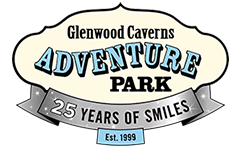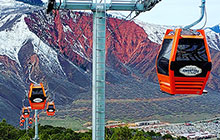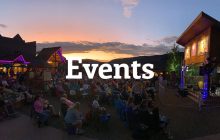Historic Fairy Caves
The Historic Fairy Caves, an attraction within Glenwood Caverns Adventure Park, was a thriving tourist destination in the 1890s thanks to Charles W. Darrow, a pioneering Glenwood Springs attorney. Darrow and his family homesteaded the top of Iron Mountain, including the cave entrance. Today, visitors can tour the Historic Fairy Caves as well as King’s Row, the most highly decorated cave room in Colorado. Darrow opened the Fairy Caves to visitors in 1895. At that time the known extent of the cave was about 800 feet. Today Glenwood Caverns has more than 16,000 known feet. When the Fairy Caves opened to the public, visitors could get to the caves by walking up a trail, by riding a horse or burro, or by being transported in style in a horse-drawn carriage. Visitors to the Historic Fairy Caves today travel on the Glenwood Gondola.
Darrow installed a pathway up to the cave and by 1897 had wires strung up the mountain from the hydroelectric plant in the town of Glenwood Springs. Glenwood Springs was a popular tourist destination during the late 1800s and was one of the first cities in the United States with electric lights. Because of the progressive citizens of Glenwood Springs, the Fairy Caves became one of the first caverns in the world to be lit by electricity. Today, visitors can see the holes in the walls of the cave where the electric lights were installed more than a hundred years ago.
In 1897 Darrow blasted a tunnel from the innermost part of the known cave to the open air looking down on the Roaring Fork Valley and the Colorado River. Visitors today can stand on the same platform that Darrow built and named Exclamation Point. Visitors get to this balcony on the Historic Fairy Caves Tour by stepping onto an outdoor platform on a steep cliff high up on Iron Mountain. The view is breathtaking and extends for miles both east and west.
The town of Glenwood Springs rapidly developed when the railroad arrived in 1887. The hot springs pool, the Natatorium, opened in 1888, and the deluxe Hotel Colorado opened in 1893. The Hot Springs Lodge & Pool is now a year-round destination spa. The Hotel Colorado is a massive structure modeled after the Villa de Medici, a 16th century Italian mansion. This opulent Victorian hotel has hosted many important visitors, including Presidents William Howard Taft and Theodore Roosevelt. Teddy Roosevelt brought a large party to hunt in the woods surrounding Glenwood Springs. According to local legend, Teddy Roosevelt returned from the hunt one day empty-handed. The hotel maids stitched together a small bear from scraps of cloth and presented it to the President to lift his spirits. Thus was born the Teddy Bear, named by a local reporter.
At the time Darrow was developing the site as a tourist destination, the scientific community knew little about the preservation of caves. Unfortunately, when heat and outside air are allowed into a cave as was done with the portion of the cave known as the Fairy Caves, the cave stops growing and living. Darrow’s sons operated the cave until 1915. The Historic Fairy Caves were closed for more than 80 years until the current owners, Steve and Jeanne Beckley, using contemporary scientific cave preservation methods, opened them to the public in 1999. Today’s visitors will experience both Historic Fairy Caves and the living Glenwood Caverns sections of the cave that have been protected and preserved by the Beckleys. The living caves are moist, maintain a constant 52 degrees and continue to grow the stunning crystalline formations. Although the Historic Fairy Caves had been damaged by neglect, since the Beckleys have owned them and applied rigorous preservation methods, they are growing once again.
Note: Acknowledgement for his work and thanks to Jim Nelson, Glenwood Springs historian, author of Glenwood Caverns and the Historic Fairy Caves.
Modern Cave Science
Glenwood Caverns, a living cave near Glenwood Springs, Colorado, and a part of Glenwood Caverns Adventure Park, is a sustainable resources success story that reflects what can be done to both preserve priceless natural resources and make them accessible to the public.
Caves depend on moisture and humidity to keep dripping and growing cave formations. Commercial cave owners in the 1890s did not understand this and allowed portions of the cave to dry out. The public enjoyed the cave from 1895 through 1917, and then the Darrow family, owners of the cave since their ancestor Charles Darrow homesteaded the area in the 1890s, closed the caverns. Unfortunately, when the cave was closed to the public, the entrance was not sealed. From 1917 through 1961 the cave wasn’t protected from casual visitors and several generations of teenagers and hikers explored the site, often removing cave formations as souvenirs. The known portion of the Fairy Caves was exposed to the dry outside air, and eventually dried up and stopped growing.
In 1952, the modern exploration of Glenwood Caverns began. Members of the Colorado Grotto Club, led by Glenwood Springs resident James Kitt, visited the Fairy Caves. These experienced cavers guessed that this one section was only a small part of a much larger cavern network. In 1953 the group returned and began exploring in earnest. The group first found new passages into the mountain from the Fairy Caves. These new areas, christened the Register Room and the Pendant Room, were large and doubled the size of the known caverns. Fortunately, these new areas were also living cave, still in its pristine ancient state, still dripping and growing. In 1954, the cavers felt a breeze blowing from a hole, followed that airflow, and discovered what they named the Drum Room and the Canyon.
In 1960, curious and courageous cavers discovered a vertical passage at the back of Fairy Caves and followed this narrow passage 30 feet down. At one place, the passage shrinks to 8 ½ inches wide. The cavers squeezed through this tiny space by exhaling, squeezing downwards, stopping, inhaling, exhaling again, and continuing to slowly move through the narrow opening. This experience led the cavers to name the passage the Jam Crack.
After the cavers had negotiated the Jam Crack, they were faced with another narrow passage, roughly horizontal. For obvious reasons the cavers named this passage Purgatory and continued to exhale, squeeze, inhale and painfully work their way through the passage. The trip through Purgatory was worth it, because the cavers found several enormous rooms with a fantastic array of pristine formations. The cavers named the two largest rooms The Barn and King’s Row. The reason for naming The Barn is clear; after all, it is big as a barn, but the cavers gave the fanciful name King’s Row because this huge room has a series of formations that look like chess pieces.
Visitors today can stand in both The Barn and King’s Row and view the stunning formations, and they no longer must squeeze through the Jam Crack or go through Purgatory to get there. They can walk down a safe set of stairs with hand railings, accompanied by a knowledgeable and experienced guide, and view these same awesome formations discovered by the cavers.
Peter P. Prebble, Robert Wilber, and Robert O’Connell, members of the Colorado Grotto Club, bought the caves and surrounding acreage from the Darrow family in 1961. Soon after the purchase, they installed a locked gate at the entrance to the caverns, effectively barring entrance to the uninvited. Prebble, Wilber, and O’Connell intended to reopen the caves, but their plans did not materialize.
From 1961 through 1998, a handful of cavers continued to explore the caverns, but the cave was still closed to the public. Steve Beckley, who grew up in the Rocky Mountains and had been a caver since childhood, was a student at the Colorado School of Mines when he read about the Fairy Caves in an out-of-print book, “Caves of Colorado.” Steve graduated and began working as a petroleum engineer, but he never forgot about the Fairy Caves. In 1982 he contacted the owners of the caves to explore development of the caves to admit the public; however, they were unable to agree.
Steve persisted for the next sixteen years and, in 1998, reached an agreement with the owners under which he would be allowed to develop the property. During those years of negotiations, he continued to study what information was known about the cave. In 1992, for the first time Steve and Jeanne Beckley, his wife and partner in Glenwood Caverns Adventure Park, put on kneepads and headlamps and squeezed through Jam Crack. Peter Prebble, one of the three owners, a caver himself and very protective of the integrity of the undeveloped caverns, insisted that an emergency room physician from Texas, a friend of Prebble and an experienced caver himself, accompany them.
After this exploration trip, the Beckleys vowed to do whatever they could to gain control of the cave and reopen the historic section and open a new living section to the public. In 1998, they began the substantial improvement projects necessary to allow the public to view this natural wonder. The first step was to grade and gravel a road up to the cave entrance and then clear the Historic Fairy Caves of the debris that had collected there for decades. They hired Evan Anderson, a local caver with knowledge in wiring, to rewire the Historic Fairy Caves by replacing the 1897 wiring and installing modern equipment to illuminate and emphasize the formations. Today’s visitors can see the holes in the sides where the lights guided visitors in 1897, as well as recreated period lighting on the Historic Fairy Caves Tour.
Because the purpose of development was to make the living cave accessible to the public and still not harm the cave, the Beckleys decided to carve a new tunnel into the mountain, one that could control temperature and humidity and preserve the formations. They hired surveyors to help determine the proper path for the new tunnel. Steve and his workers squeezed through the Jam Crack several times to set up antennas deep within the Barn to guide the surveyors. After the surveyors had completed the measurements, the Beckleys hired Dean Mussati, lead engineer of Mining and Environmental Services, to blast the tunnel 132 feet through the cliff.
Prior to the completion of the tunnel, they installed two airtight doors in the new tunnel to form an airlock. The doors are 50 feet apart so that when visitors enter the airlock, the door closes behind them.
With the help of this airlock, the ideal humidity and temperature of the caverns can be maintained, ensuring the continuing growth of the age-old formations. The Beckleys enlisted cavers to install temperature and humidity monitors to ensure that the integrity of the ancient formations is maintained. The interior of the cave is a stable 52 degrees year-round. For the visitor coming from the outside, the caverns feel cool in the summer and warm in the winter.
Because of Steve and Jeanne Beckley’s vision and courage, Glenwood Caverns and Historic Fairy Caves are now protected, able to continue to grow naturally, and yet are accessible to the public. The Colorado Governor’s Office of Tourism recognized the Beckleys for their exemplary preservation efforts and selected them as the only winners of the 2001 Governor’s Award for Outstanding Community Tourism Initiative.
Cave History | Fantastic Formations
Timeline
- 1895 Charles Darrow opened the Fairy Caves to the public
- 1897 Darrow installed electric lights in the cave
- 1917 Darrow family closed the cave to the public
- 1999 Steve and Jeanne Beckley opened Glenwood Caverns and Historic Fairy Caves to the public
- 2003 Launched Glenwood Caverns Adventure Park; opened the Iron Mountain Tramway, a mountaintop restaurant, gemstone sluice box mining and a sand pit fossil dig
- 2005 Added the first Alpine Coaster in the U.S., the Swing Shot (replaced in 2010) and a 32’ climbing wall
- 2007 Added the Wild West Wagon, which has since been retired
- 2008 Added the Fort WhereAmI giant maze, which has since been replaced with group and event space
- 2009 Added Colorado’s first 4D Motion Theater, a laser tag arena, the GiddyUp! Western ride, the Mine Shaft Shootin’ Gallery and speleobox cave simulator, and kicked off the Music on the Mountain concert series
- 2010 Added the Giant Canyon Swing
- 2011 Added the Soaring Eagle Zip Ride
- 2012 Added the Cliffhanger Roller Coaster, the Wild West Express family roller coaster and the Mine Wheel Ferris wheel ride
- 2013 Expanded the Historic Fairy Caves Tour and added six new gondola cabin cars to the Iron Mountain Tramway
- 2014 Added the Glenwood Canyon Flyer and more free entertainment, including the Cowboy Camp and the Blacksmith Shop
- 2017 Added a new melodrama, remodeled plaza and groups area
- 2019 New, detachable Glenwood Gondola opens in March, replacing the former tramway.




